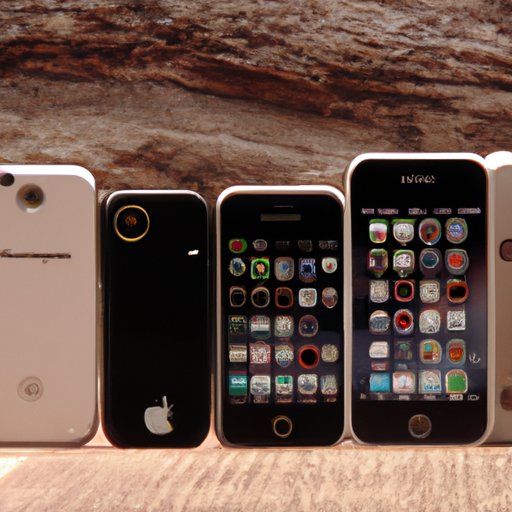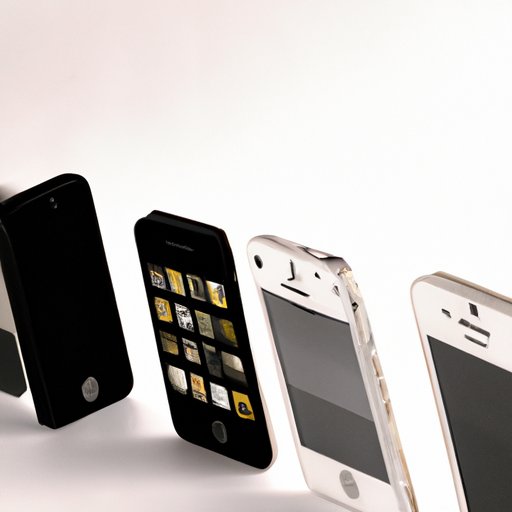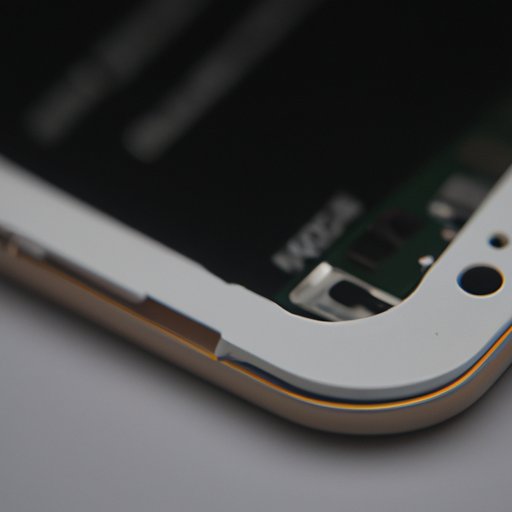Introduction
The iPhone has revolutionized the way we communicate and interact with technology. Since its inception in 2007, the iPhone has become one of the most popular and influential pieces of technology in the world. But what year was the iPhone invented? In this article, we will explore the history of Apple’s iconic invention and its impact on the cellular industry.
A Timeline of Apple’s iPhone: From Inception to Present
The iPhone was first unveiled by Steve Jobs in January 2007. It was the result of years of research and development at Apple, and it quickly became a symbol of the company’s innovation and leadership in the tech industry. Since then, the iPhone has gone through several iterations and upgrades, becoming faster, more powerful, and more feature-rich with each new generation.
Overview of the iPhone’s Development
The original iPhone featured a 3.5-inch touchscreen display and a 2-megapixel camera. It ran on a modified version of Mac OS X, and it was powered by an ARM processor. The device also had Wi-Fi and Bluetooth connectivity, as well as the ability to access the iTunes Store. Over the years, Apple has continued to update and improve the iPhone, adding features such as larger displays, better cameras, faster processors, and improved battery life.
Significant Milestones in iPhone History
The original iPhone was followed by the iPhone 3G in 2008, which added support for 3G networks and GPS capabilities. The iPhone 3GS was released in 2009 and included a faster processor, a digital compass, and voice control. The iPhone 4 was released in 2010 and featured a higher resolution display, a front-facing camera, and FaceTime video calling. The iPhone 4S was released in 2011 and added Siri, Apple’s virtual assistant.
In 2012, Apple released the iPhone 5, which included a larger 4-inch display, an 8-megapixel camera, and LTE connectivity. The iPhone 5S and 5C were released in 2013 and featured fingerprint scanners, improved cameras, and faster processors. The iPhone 6 and 6 Plus were released in 2014 and featured larger displays, improved cameras, and Apple Pay. The iPhone 6S and 6S Plus were released in 2015 and added pressure-sensitive 3D Touch displays.
Recent Developments in iPhone Technology
In 2016, Apple released the iPhone 7 and 7 Plus, which included water resistance and stereo speakers. The iPhone 8 and 8 Plus were released in 2017 and featured wireless charging and improved cameras. The iPhone X was released in 2017 and featured an edge-to-edge OLED display, facial recognition, and Animoji. The iPhone XS, XS Max, and XR were released in 2018 and featured faster processors, improved cameras, and a new design.
Exploring the History of Apple’s iPhone
Apple’s journey to invent the iPhone began in 2004 when the company acquired a small software development firm called Pixo. The team at Pixo worked on creating a mobile operating system that could be used for a variety of devices. In 2005, Apple hired former Microsoft executive Jon Rubinstein to lead the iPhone project. He assembled a team of engineers to develop the hardware and software for the device.
Apple’s Vision for the iPhone
Steve Jobs, who had been CEO of Apple since 1997, envisioned the iPhone as a device that would combine the functionality of a computer with the convenience of a cell phone. He wanted the device to be easy to use and intuitive, and he wanted it to have features that no other phone had. Jobs wanted the iPhone to be a revolutionary product that would change the way people interacted with technology.
The Challenges of Developing a Smartphone
Creating a smartphone was no easy task. Apple faced numerous challenges, from developing the hardware and software to securing deals with cellular carriers. The team also had to figure out how to make the device appealing to consumers, and they had to create a marketing plan that would convince people to buy the device. Despite these challenges, Apple was able to successfully launch the iPhone in June 2007.
The Impact of the iPhone on the Cellular Industry
The iPhone’s release had a significant impact on the cellular industry. Prior to the iPhone’s release, cell phones were primarily used for making calls and sending messages. With the introduction of the iPhone, consumers could now access the internet, take pictures, play games, and perform a variety of other tasks. This changed the way people thought about cell phones, and it sparked a new wave of innovation in the cellular industry.

The iPhone Revolution: How the iPhone Changed the Smartphone Industry
The iPhone revolutionized the smartphone industry. Before the iPhone, smartphones were clunky and expensive devices that were only used by businesses and tech enthusiasts. The iPhone changed all that by offering a sleek and intuitive design at an affordable price. Consumers responded enthusiastically to the iPhone, and Apple quickly became the leader in the smartphone market.
Apple’s Impact on the Smartphone Market
Apple’s success with the iPhone led to a surge in interest in smartphones. Other companies began releasing their own devices, and the market for smartphones exploded. By 2011, smartphones accounted for more than half of all mobile phone sales worldwide. Apple’s success with the iPhone also prompted other companies to focus on creating innovative products, leading to the emergence of other popular devices such as the Samsung Galaxy and Google Pixel.
The Expansion of Smartphone Applications
The iPhone also helped spur the growth of the mobile app market. Prior to the iPhone, there were few apps available for mobile phones. With the introduction of the App Store in 2008, developers were now able to create apps specifically for the iPhone. This opened up a new world of possibilities, and the App Store quickly became one of the most popular sources for mobile apps.
The Emergence of Other Smartphone Brands
The success of the iPhone also led to the emergence of other smartphone brands. Companies such as Samsung, LG, and HTC began releasing their own devices, and they quickly gained market share. These companies adopted many of Apple’s ideas, such as large touchscreen displays and app stores, and they began competing with Apple for customers.

How the iPhone Changed Our Lives: A Look at its Invention
The iPhone has had a profound impact on our lives. It has changed the way we communicate, shop, and entertain ourselves. It has made it easier to stay connected with friends and family, and it has given us unprecedented access to information and services. The iPhone has also had a major impact on the economy, with the App Store alone generating billions of dollars in revenue.
The Benefits of the iPhone
The iPhone has many benefits. It is a powerful device that can be used for a variety of tasks. It is also incredibly user-friendly, with a simple and intuitive interface. The App Store has revolutionized the way we find and use apps, and the device’s long battery life ensures that you can always stay connected.
The Popularity of the iPhone
The iPhone has become one of the most popular pieces of technology in the world. According to a survey conducted by the Pew Research Center, 88% of American adults own a smartphone, and the majority of those devices are iPhones. The iPhone is also popular in other countries, with Apple selling an estimated 218 million iPhones in 2019.
The Social and Cultural Impact of the iPhone
The iPhone has also had a major impact on society and culture. It has changed the way we interact with each other and with technology. The device has also spawned a new wave of entrepreneurs, with many people using their iPhones to start businesses or create new products. The iPhone has also been credited with helping to create modern forms of communication, such as text messaging and social media.
A Look Back at the Year the iPhone was Invented
The iPhone was officially announced in January 2007, but it wasn’t released until June of that year. In the months leading up to the device’s release, Apple had been working hard to ensure that the device was ready for launch. The company had to secure deals with cellular carriers, create a marketing plan, and refine the device’s design.
Events Leading Up to the iPhone’s Release
In March 2007, Apple held a secret event to show off the iPhone. Journalists and industry insiders were invited to attend, and the event generated a great deal of hype and anticipation. On April 29th, Apple announced the official release date for the device, and pre-orders began on May 11th.
The Introduction of the iPhone
On June 29th, 2007, the original iPhone was released. It was met with an overwhelmingly positive response, with people praising the device’s design and features. The iPhone quickly sold out in stores, and it went on to become one of the most successful products in Apple’s history.
The Response to Apple’s New Product
“It’s the most important thing I’ve ever done,” said Steve Jobs in a 2007 interview. “It’s not just a phone. It’s a leapfrog product that is way smarter than any mobile device has ever been, and super-easy to use. We’ve put a lot of thought into this, and I think we’ve come up with something really special.”
Conclusion
The iPhone was first introduced in 2007, and it has since become one of the most popular and influential pieces of technology in the world. Its release changed the way people viewed cell phones and sparked a revolution in the smartphone industry. The iPhone has had a major impact on our lives, and its invention has been credited with helping to create modern forms of communication. As we look back on the year the iPhone was invented, it’s clear that it was a revolutionary product that changed the way we interact with technology.
(Note: Is this article not meeting your expectations? Do you have knowledge or insights to share? Unlock new opportunities and expand your reach by joining our authors team. Click Registration to join us and share your expertise with our readers.)
